Associated with Revolutionary and later
Imperial France. The three colours in vertical stripes were
first used as a canton on Naval flags in 1790, and extended
to the whole field in 1794. One of the flags in the naval
signalling alphabet is still a red-white-blue vertically striped
flag - ie like the modern French flag, but with the colours
reversed. The French National Convention adopted the modern
blue-white-red flag as the national flag on 15 February 1794
(or 27 pluviôse an II in the revolutionary calendar). The
relevant part of the decree says, in translation:


II. The national flag shall be formed of the three national colours,
set in three equal bands, vertically arranged so that the blue is nearest to the
staff, the white in the middle, and the red flying.

 The
Tricolore went out of use with Napoléon's defeat at Waterloo.
It was replaced by a white flag (c/f the old royal flag)
from 1814 to 1830. During the July revolution of that year
the Tricolore was re-established by the Marquis de Lafayette
under the relatively liberal regime of Louis-Philippe. It
has remained in use ever since. The present Constitution
of the French Republic (1958) declares: L'emblème national
est le drapeau tricolore, bleu, blanc, rouge (The national
emblem is the tricolor, blue, white, red, flag). When hoisted
vertically, the French national flag is often forked.
The
Tricolore went out of use with Napoléon's defeat at Waterloo.
It was replaced by a white flag (c/f the old royal flag)
from 1814 to 1830. During the July revolution of that year
the Tricolore was re-established by the Marquis de Lafayette
under the relatively liberal regime of Louis-Philippe. It
has remained in use ever since. The present Constitution
of the French Republic (1958) declares: L'emblème national
est le drapeau tricolore, bleu, blanc, rouge (The national
emblem is the tricolor, blue, white, red, flag). When hoisted
vertically, the French national flag is often forked.



 The
three vertical coloured bands were not always of equal width,
and on the French naval jack they are still not of equal
width. The idea is that unequal bands can look more equal
that genuinely equal ones when the flag is flying. Whether
or not it works in real life, is difficult to tell - it
certainly does not work well for flat rectangles on the
page (see the flag on the left).
The
three vertical coloured bands were not always of equal width,
and on the French naval jack they are still not of equal
width. The idea is that unequal bands can look more equal
that genuinely equal ones when the flag is flying. Whether
or not it works in real life, is difficult to tell - it
certainly does not work well for flat rectangles on the
page (see the flag on the left).




 The
flag features on an official
French logo shown on the left, along with Marianne
and French
national motto. It is sometimes represented as a coat
of arms as on the right, most people not knowing and not
recognising the (semi-official) coat
of arms of France.
The
flag features on an official
French logo shown on the left, along with Marianne
and French
national motto. It is sometimes represented as a coat
of arms as on the right, most people not knowing and not
recognising the (semi-official) coat
of arms of France.
The French tricolore has provided a model for the
flags of other Republics - for example Italy and Ireland among many others. But
it is not restricted to republics. Belgium for example, a monarchy, uses a tricolore.
The French national flag is one of the sybols of sovereignty mentioned in article 2 of the French Constitution of 1958: "L'emblème national est le drapeau tricolore, bleu, blanc, rouge."
High French officials use personal banners based on the
French tricolore. Presidents since de Gaule deface the banner
with their own personal device. Banners of other officials
are standardised like the examples below:
Prime Minister | Minister
of National Defence | Joint
Chief of Staff | Naval
Chief of Staff | | |
|
|
|
|
| | |
Admirals
also use defaced banners:
Fleet Admiral | Fleet
Vice Admiral | Vice
Admiral | Rear Admiral | certain
Captains | |
|
|
|
|
|
| |
Here
are some other examples:
Minister of Overseas
Departments & Territories | Maréchal
de France | Army
Chief of Staff | Air
Force Chief of Staff | General
Delegate for Armament | |
|
|
|
|
|
| |
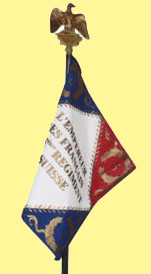
 Military
flags use the same colours but a different design with a
white lozenge in the middle. On the left is the flag of
one of Napolean's regiments.
Military
flags use the same colours but a different design with a
white lozenge in the middle. On the left is the flag of
one of Napolean's regiments.

 On
the right is the flag of the Free French Navy with the cross
of Lorraine (Croix de Lorraine) in a white lozenge. This
jack is still hoisted today on warships of the French Navy
named after Free French Naval units.
On
the right is the flag of the Free French Navy with the cross
of Lorraine (Croix de Lorraine) in a white lozenge. This
jack is still hoisted today on warships of the French Navy
named after Free French Naval units.
 French
Yacht Club Flags
French
Yacht Club Flags







 You
will notice that almost no private individual in the Languedoc
flies the French Tricolore flag, though many fly the flag
of the old
Counts of Toulouse, with the famous
Cross of Toulouse. Many mairies will fly this flag along
with the tricolore and the flag of the European Community.
You
will notice that almost no private individual in the Languedoc
flies the French Tricolore flag, though many fly the flag
of the old
Counts of Toulouse, with the famous
Cross of Toulouse. Many mairies will fly this flag along
with the tricolore and the flag of the European Community.

 A
minor footnote: The annual `rent' paid by The Duke of
Marlborough to the English Crown for the royal manor of
Woodstock and Blenheim Palace is a Royal French flag, "Argent
three fleurs-de-lys Or" as shown on the right. It dates
from the victory of John Churchill at Blenheim in 1704,
well before the French Revolution, when this was the French
national flag.
A
minor footnote: The annual `rent' paid by The Duke of
Marlborough to the English Crown for the royal manor of
Woodstock and Blenheim Palace is a Royal French flag, "Argent
three fleurs-de-lys Or" as shown on the right. It dates
from the victory of John Churchill at Blenheim in 1704,
well before the French Revolution, when this was the French
national flag.

 The
Duke of Wellington pays a similar rent for his property,
also granted in recognition of military victory. His victory,
at Waterloo, occurred just over a century later, in 1805,
after the French Revolution. Each year he presents as rent
a tricolore, the national French flag in 1805.
The
Duke of Wellington pays a similar rent for his property,
also granted in recognition of military victory. His victory,
at Waterloo, occurred just over a century later, in 1805,
after the French Revolution. Each year he presents as rent
a tricolore, the national French flag in 1805.


![]()
![]() The
French National Flag. Only one visual symbol has the
official sanction of the Constitution: the tricolore flag
(tricolore drapeau). It is sometimes referred to as a tricolour
(UK) or tricolor (US) or tricoleur.
The
French National Flag. Only one visual symbol has the
official sanction of the Constitution: the tricolore flag
(tricolore drapeau). It is sometimes referred to as a tricolour
(UK) or tricolor (US) or tricoleur. 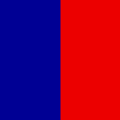
![]()

![]() The
colours are those of Paris (blue and red) combined with
the Royal white (the dispossession and execution of the
King still lay in the future when the tricolore was first
used).
The
colours are those of Paris (blue and red) combined with
the Royal white (the dispossession and execution of the
King still lay in the future when the tricolore was first
used). 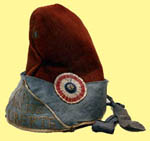








 The
flag features on an official
The
flag features on an official 








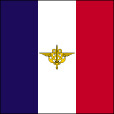
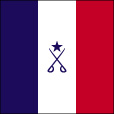


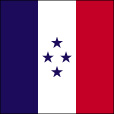




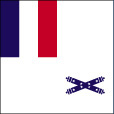

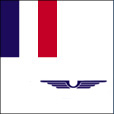



 French
Yacht Club Flags
French
Yacht Club Flags







